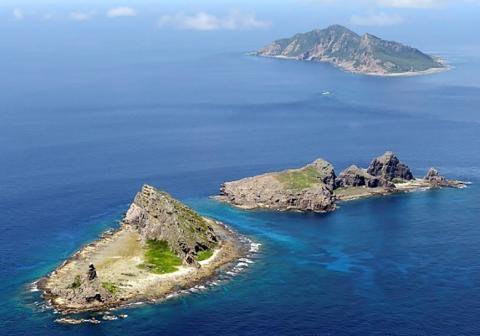The Ministry of Foreign Affairs yesterday reasserted Taiwan’s sovereignty over the Diaoyutai Islands (釣魚台) in the disputed East China Sea, after the Japanese government expedited a plan to include Japan’s territorial claims over the island chain in its school curriculum.
The Japanese Ministry of Education, Culture, Sports, Science and Technology on Tuesday announced that it is moving up implementation of its “national territory education” curriculum from 2022 to next year, according to a Kyodo News report.
Japanese high-school students are to be taught about the legitimacy of Japan’s territorial claims over several disputed islands, including Diaoyutai, as well as islets in the Sea of Japan known as Takeshima in Japan and Dokdo in South Korea.

Photo: Reuters
“The government has maintained a consistent stance on the issue, which is that the Diaoyutai Islands are part of the Republic of China’s territory,” ministry spokesman Andrew Lee (李憲章) said in a press release.
The reality that Taiwan enjoys sovereignty over the archipelago is not going to be changed by any country’s decision to categorize it as their own territory in school textbooks, Lee said.
The Taiwanese government has always advocated for a peaceful solution to territorial disputes to avoid situations in which a concerned party’s unilateral actions lead to heightened tensions in the region, Lee said.
The Diaoyutais, about 120 nautical miles (222.2km) northeast of Taipei, are also claimed by China.
To prevent tensions in the region from escalating, then-president Ma Ying-jeou (馬英九) in 2012 proposed the East China Sea peace initiative while visiting Pengjia Islet (彭佳嶼), about 56km north of Taiwan proper.
The initiative calls for all parties to take action to reduce tensions, abide by international law, ensure the freedom of navigation and overflight, and seek a peaceful resolution to disputes.
After taking office in 2016, President Tsai Ing-wen (蔡英文) has adopted a similar approach, reiterating Taiwan’s sovereignty over Diaoyutais while calling for a peaceful resolution to territorial disputes.

Beijing could eventually see a full amphibious invasion of Taiwan as the only "prudent" way to bring about unification, the US Department of Defense said in a newly released annual report to Congress. The Pentagon's "Annual Report to Congress: Military and Security Developments Involving the People's Republic of China 2025," was in many ways similar to last year’s report but reorganized the analysis of the options China has to take over Taiwan. Generally, according to the report, Chinese leaders view the People's Liberation Army's (PLA) capabilities for a Taiwan campaign as improving, but they remain uncertain about its readiness to successfully seize

Taiwan is getting a day off on Christmas for the first time in 25 years. The change comes after opposition parties passed a law earlier this year to add or restore five public holidays, including Constitution Day, which falls on today, Dec. 25. The day marks the 1947 adoption of the constitution of the Republic of China, as the government in Taipei is formally known. Back then the Chinese Nationalist Party (KMT) governed China from Nanjing. When the KMT, now an opposition party in Taiwan, passed the legislation on holidays, it said that they would help “commemorate the history of national development.” That

Taiwan has overtaken South Korea this year in per capita income for the first time in 23 years, IMF data showed. Per capita income is a nation’s GDP divided by the total population, used to compare average wealth levels across countries. Taiwan also beat Japan this year on per capita income, after surpassing it for the first time last year, US magazine Newsweek reported yesterday. Across Asia, Taiwan ranked fourth for per capita income at US$37,827 this year due to sustained economic growth, the report said. In the top three spots were Singapore, Macau and Hong Kong, it said. South

HORROR STORIES: One victim recounted not realizing they had been stabbed and seeing people bleeding, while another recalled breaking down in tears after fleeing A man on Friday died after he tried to fight the knife-wielding suspect who went on a stabbing spree near two of Taipei’s busiest metro stations, Taipei Mayor Chiang Wan-an (蔣萬安) said. The 57-year-old man, identified by his family name, Yu (余), encountered the suspect at Exit M7 of Taipei Main Station and immediately tried to stop him, but was fatally wounded and later died, Chiang said, calling the incident “heartbreaking.” Yu’s family would receive at least NT$5 million (US$158,584) in compensation through the Taipei Rapid Transit Corp’s (TRTC) insurance coverage, he said after convening an emergency security response meeting yesterday morning. National